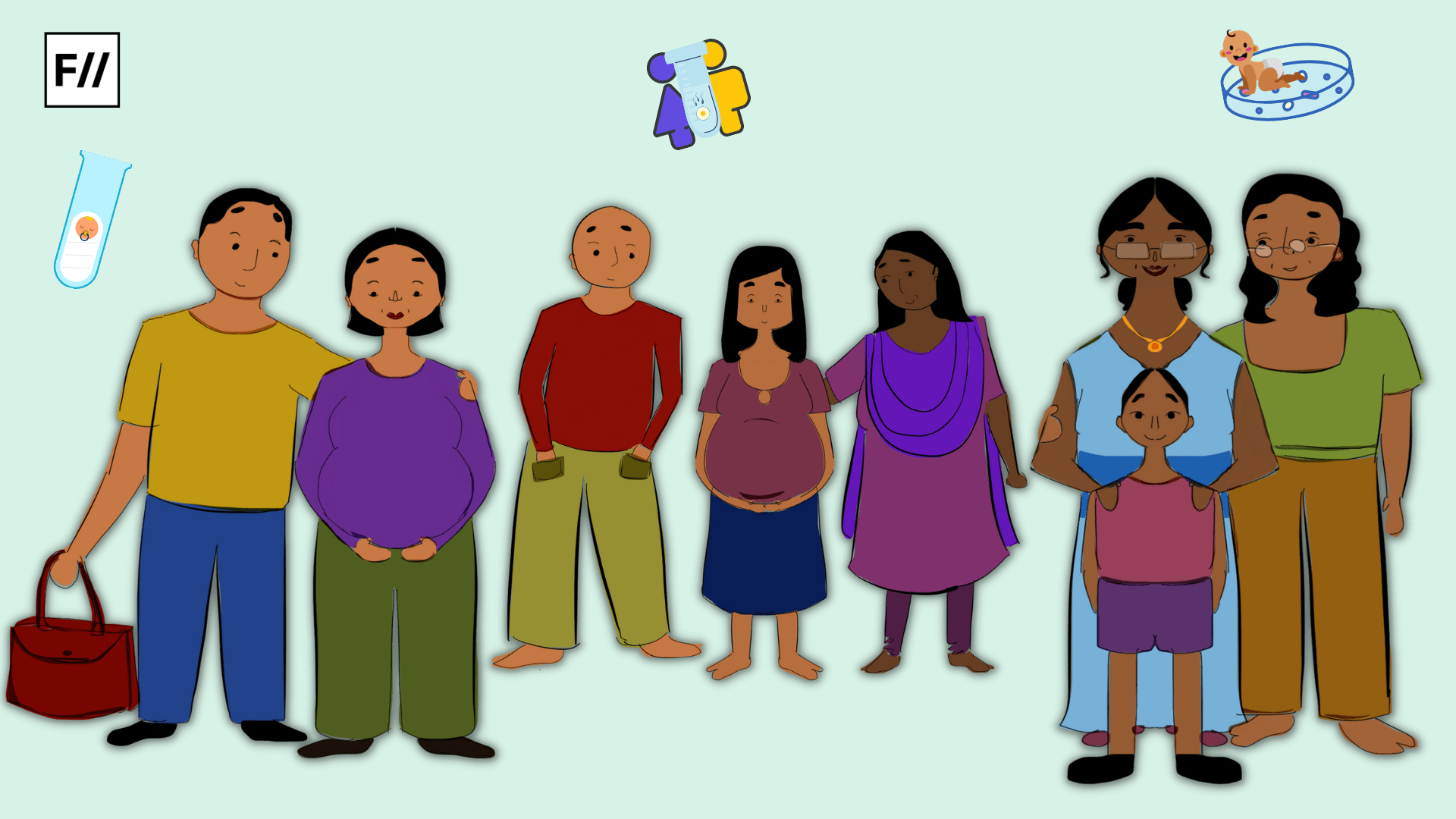Editor’s Note: FII’s #MoodOfTheMonth for September, 2021 is Parenthood. We invite submissions on the many layers of being parents, having parents and navigating the social norms of parenting throughout the month. If you’d like to contribute, kindly email your articles to sukanya@feminisminindia.com
Motherhood is painted as a blissful, intriguing and fascinating experience in media narratives. The narrative of motherhood is implanted in larger patriarchal structures that results in the naturalised association of women with mothering. Despite a myriad of cultural and social changes in desires of women in the 20th century, reproduction and motherhood have retained their priority over other assigned roles for women.
Anthropologist and author Marcia C. Inhorn in her edited volume, Infertility Around the Globe, notes that “Making babies is how women are expected to form adult identities the world over, and in non-Western “developing” societies the gendered consequences of infertility can be grave”. This is also true of the Indian socio-cultural fabric, in which motherhood is raised to such statures that a woman is considered “fragmented” without it.
These ideologies of motherhood have ramifications on the gender performances of mothering. Dominant ideologies of motherhood become problematic in the context of infertile women in the society. The presence of infertility is signaled, not by the presence of pathological symptoms, but by the absence of a desired state, since it involves an inability to achieve a desired social role. In many societies past and present, the value of women’s lives is dependent on their ability to bear children. Childlessness in India is highly engendered.

The social construction of health and illness is perhaps even more noticeable in the case of infertility than it is in other conditions. This critical perspective throws light to the ways that a diagnosis of infertility is heavily encumbered with negative meanings and qualifies as a disability. This ‘invisible disability’ within the culture construction of gendered reproduction led to the burgeoning of fertility clinics in India. The medicalisation of infertility brings into question a serious socio-cultural discourse on gender roles, motherhood, body politics and the changing landscape of the fertility industry in India.
India is a champion in providing commercial Assisted Reproductive Technology. Procreative technologies have become a dominant part of culture, as well as the scientific and healthcare industry in India. Popular culture, print and electronic media and the flourishing of IVF (in vitro fertilisation) clinics in the topography of India has normalised the idea of ‘test-tube’ babies.
In the 1990s, with the advent of globalisation and other liberal economic policies, India emerged as a market for Assisted Reproductive Technology. The medicalisation of infertility in the nineteenth century turned sufferers into patients, and with the diabolical combination of neoliberalism, globalisation, free market capitalism and the growth of new reproductive technologies in the twenty first century, the same patients turned into consumers.
People often fail to recognise the marketing strategy adopted by the fertility industries in creating a sense of reproductive desire among the sufferers turned patients. They give paramount importance to the consumption pattern and this results in the exploitation and subjugation of women
Assisted Reproductive Technologies themselves are gendered technologies, with highly specific and differentiated applications on men’s and women’s bodies (Konrad 1998). From a cultural-economic viewpoint, the linking of social or medical priorities with uncertain outcomes provides a market space for the commodification of human desires. Desire plays a key role in endorsing the societal norms of fertility behavior through the ‘microphysics of power’ (Foucault’s idiom).
Capitalism operates at its maximum in observing individuals’ cherished desires and customising this information to keep the wheels of consumerism rolling. The Assisted Reproductive Technology market engages dynamic advertising strategies through the use of wall advertisements, delightfully designed posters, wonderful websites, street hoardings, and media, print and institutional advertisements.
The advertisements focusing infertility often use the images of smiling babies, confusing statistics and positive pregnancy test results which emphasise the commercial nature of reproductive technologies in persuading patients to choose their clinics over their industrial competitors.

Advertisement is an ideological arm of fertility markets in creating a sense of reproductive desire among infertile women. Reproductive desire is at once a profoundly personal emotion and a social construct. Culture, economy, religion, gender and technology process and shape different forms of reproductive desires.
The reinforcement of maternal images by the global capital industries influences stigmatised women to undergo experimental treatment procedures. Institutional advertisements illustrating the advancements in procreative technologies have played a vital role in normalising assisted conception in India. The pervasive access to the health- related information on the Internet is altering the way Indians access their healthcare.
It is the woman’s body which is most often subjected to the medical gaze. The fertility industry includes diverse treatment options, the most popular of which is the IVF. The construction of both professional and popular discourses that misrepresent its triumphs, exaggerate its successes and lionise the institutional system of provision- the standard hospital based, male dominated medical hierarchy – plays a contributing role to establish this low expensive, low success and moderately unsafe innovation as the centerpiece treatment for involuntary childlessness. These fertility industries thrive on patriarchy, poverty and the media
This online revolution has a significant impact on the assisted reproductive market technology in India. Fertility clinic websites emphasise several interesting insights on the cutting edge technology, patient stories, and IVF success rates to influence the patients to embark on a transformative medical journey with them.
Assisted Reproductive Technology is expensive. With each IVF cycle costing about Rupees 60,000 to Rupees 2 lakhs, the financial strain intensifies trauma and angst among people undergoing fertility treatments. In the absence of regulation in Assisted Reproductive Technology markets, clinics in India are still able to claim far higher success rates than they actually have, and the results of this can be catastrophic. Narratives of anxiety and depression after unsuccessful IVF attempts and the tormenting wait for conception, as well as the financial drain for the patients undergoing the treatment procedures do not find their way into mainstream media narratives.
Also read: Artificial Reproductive Technologies: Reimagining The Notions Of Parenthood

Gene Corea’s influential work Man- Made Women: How the New Reproductive Technologies Affect Women discusses how new procreative technologies administer patriarchal roles and objectify the procreative capacity of women. Corea believes that an all pervasive, irresistible natalism entangles women and forces them to reproduce. This scenario brings them to a familiar juncture where this idea of procreation gets deeply engraved.
Regardless of which partner has a “problem”, it is the woman who is the prime locus of fertility problems. It is her body that is the emplacement of artificial insemination or in vitro fertilisation (IVF). Fertility markets use the narrative space of advertisements to underpin gender power hierarchies and seek to define the performativity of gender.
It is the woman’s body which is most often subjected to the medical gaze. The fertility industry includes diverse treatment options, the most popular of which is the IVF. The construction of both professional and popular discourses that misrepresent its triumphs, exaggerate its successes and lionise the institutional system of provision- the standard hospital based, male dominated medical hierarchy – plays a contributing role to establish this low expensive, low success and moderately unsafe innovation as the centerpiece treatment for involuntary childlessness. These fertility industries thrive on patriarchy, poverty and the media.

Anita Jayadevan’s fascinating memoir Malicious Medicine: My Experience with Fraud and Falsehood in Infertility Clinics, describes the treatment practices and medical diagnoses by fertility clinics in treating infertility. These clinics recirculate and (re)produce normativity in the name of Assisted Reproductive Technology.
The author narrates the emotional turmoil and physical ordeal she went through. It further illustrates how the physicians play pivotal roles in making profits at consumer’s expense. “We recalled seeing a very high-sounding and flamboyant full page advertisement of a clinic in a prominent newspaper on 31 January 2000. It claimed the clinic had unfailing systems which could correct infertility” (Jayadevan, 14).
These campaign narratives populate ideologies embedded in our culture as the result of amalgamation of science, technology, industry and society. Through this memoir, she urges for a regulatory body for Assisted Reproductive Technology in India to monitor the functioning of fertility clinics.
These narratives successfully employ the usual tactics of gender politics and thereby glorify motherhood. Health and health services are dynamic outcomes of changing socio-economic, technological and biological conditions. Assisted Reproductive Technologies are more than mere technologies. They have profound implications in the existing societal norms and power relations.
People often fail to recognise the marketing strategy adopted by the fertility industries in creating a sense of reproductive desire among the sufferers turned patients. They give paramount importance to the consumption pattern and this results in the exploitation and subjugation of women.
Also read: Surrogacy Regulation Bill 2019: Altruism Or State Control Of Bodily Autonomy?
References
1. Balen, Frank and Marcia Inhorn. Infertility Around the Globe: New Thinking on Childlessness,
2. Gender and Reproductive Technologies. University of California Press, 2002.
3. Corea, Gena. Man-Made Women: How New Reproductive Technologies Affect Women.4. Indiana University Press, 1987.
4. Jayadevan, Anitha. Malicious Medicine: My Experience with Fraud and Falsehood in Infertility Clinics. Penguin Books India, 2009.
5. Konrad, Monica. “Ova Donation and Symbols of Substance: Some Variations on the Theme of Sex, Gender and the Partible Body.” The Journal of the Royal Anthropological Institute, vol. 4, no. 4, 1998, p. 643.
Sethulakshmi A. is a Junior Research Fellow in English Literature. An intersectional feminist at heart, she believes that coffee makes the world a better place. She is a blogger, travel enthusiast, an advocate for gender equality and an ally to gender non conforming people. You may find her on Instagram
Featured Image: Ritika Banerjee for Feminism In India




